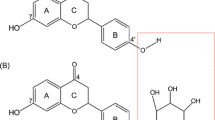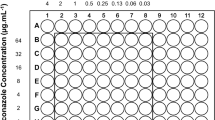Abstract
Using the 3114/3115 thermal activity monitor (TAM) air isothermal microcalorimeter, ampoule mode, the heat output of Candida albicans growth at 37°C was measured, and the effect of emodin on C. albicans growth was evaluated by microcalorimetry coupled with chemometric methods. The similarities between the heat flow power (HFP)–time curves of C. albicans growth affected by different concentrations of emodin were calculated by similarity analysis (SA). In the correspondence analysis (CA) diagram of eight quantitative parameters taken from the HFP–time curves, it could be deduced that emodin had definite dose-effect relationship as the distance between different concentrations of it increased along with the dosage and the effect. From the principal component analysis (PCA) on eight quantitative parameters, the action of emodin on C. albicans growth could be easily evaluated by analyzing the change of values of the main two parameters, growth rate constant k 2 and maximum power output \( P_{\text{m}}^2 \). The coherent results of SA, CA, and PCA showed that emodin at different concentrations had different effects on C. albicans growth metabolism: A low concentration (0–10 μg ml−1) poorly inhibited the growth of C. albicans, and a high concentration (15–35 μg ml−1) could notably inhibit growth of this fungus. This work provided a useful idea of the combination of microcalorimetry and chemometric analysis for investigating the effect of drug and other compounds on microbes.






Similar content being viewed by others

References
Ah UV, Wirz D, Daniels AU (2008) Rapid differentiation of methicillinsusceptible Staphylococcus aureus from methicillin-resistant S. aureus and MIC determinations by isothermal microcalorimetry. J Clin Microbiol 46:2083–2087
Batovska D, Parushev S, Slavova A, Bankova V, Tsvetkova I, Ninova M, Najdenski H (2007) Study on the substituents’ effects of a series of synthetic chalcones against the yeast Candida albicans. Eur J Med Chem 42:87–92
Bevina CJ, Dambergsb RG, Fergussona AJ, Cozzolinob D (2008) Varietal discrimination of Australian wines by means of mid-infrared spectroscopy and multivariate analysis. Anal Chim Acta 621:19–23
Chardin B, Dolla A, Chaspoul F, Fardeau ML, Gallice P, Bruschi M (2002) Bioremediation of chromate: thermodynamic analysis of the effects of Cr (VI) on sulfate-reducing bacteria. Appl Microbiol Biotechnol 60:352–360
Chen RF, Shen YC, Huang HS, Liao JF, Ho LK, Chou YC, Wang WY, Chen CF (2004) Evaluation of the anti-inflammatory and cytotoxic effects of anthraquinones and anthracenes derivatives in human leucocytes. J Pharm Pharmacol 56:915–919
Chen Y, Zhu SB, Xie MY, Nie SP, Liu W, Li C, Gong XF, Wang YX (2008) Quality control and original discrimination of Ganoderma lucidum based on high-performance liquid chromatographic fingerprints and combined chemometrics methods. Anal Chim Acta 623:146–156
Chen HL, Yao J, Wang L, Wang F, Bramanti E, Maskow T, Zaray G (2009) Evaluation of solvent tolerance of microorganisms by microcalorimetry. Chemosphere 74:1407–1411
Chukwujekwu JC, Coombes PH, Mulholland DA, Staden JV (2006) Emodin, an antibacterial anthraquinone from the roots of Cassia occidentalis. South Afri J Bot 72:295–297
Granqvist B, Hedström G, Rosenholm JB (2009) Acid-base interaction of probes at silica surface, microcalorimetry and adsorption. J Colloid Interf Sci 333:49–57
Guo QQ, Chen Y, Zhang B, Kang MX, Xie QP, Wu YL (2009) Potentiation of the effect of gemcitabine by emodin in pancreatic cancer is associated with survivin inhibition. Biochem Pharmacol 77:1674–1683
He DX, Bo C, Tian QQ, Yao SZ (2009) Simultaneous determination of five anthraquinones in medicinal plants and pharmaceutical preparations by HPLC with fluorescence detection. J Pharm Biomed Anal 49:1123–1127
Ho CB, Wu DD (2009) Online banking performance evaluation using data envelopment analysis and principal component analysis. Comput Oper Res 36:1835–1842
Huang ZW, Chen GC, Shi P (2009) Effects of emodin on the gene expression profiling of human breast carcinoma cells. Cancer Detect Prev 32:286–291
Kim YM, Lee CH, Kim HG, Lee HS (2004) Anthraquinones isolated from Cassia tora (Leguminosae) seed show an antifungal property against Phytopathogenic fungi. J Agric Food Chem 52:6096–6100
Kong WJ, Zhao YL, Shan LM, Xiao XH, Guo WY (2008a) Thermochemical studies on the quantity-antibacterial effect relationship of four organic acids from Radix Isatidis on Escherichia coli growth. Biol Pharm Bull 31:1301–1305
Kong WJ, Zhao YL, Shan LM, Xiao XH, Guo WY (2008b) Investigation of the effect of four organic acids in Radix Isatidis on E. coli growth by microcalorimetry. Chin J Chem 26:113–115
Kong WJ, Zhao YL, Shan LM, Xiao XH, Guo WY (2008c) Investigation on the spectrum–effect relationships of EtOAc extract from Radix Isatidis based on HPLC fingerprints and microcalorimetry. J Chromatogr B 871:109–114
Kong WJ, Zhao YL, Xiao XH, Wang JB, Li HB, Li ZL, Jin C, Liu Y (2009) Spectrum–effect relationships between ultra performance liquid chromatography fingerprints and anti-bacterial activities of Rhizoma coptidis. Anal Chim Acta 634:279–285
Kuo YC, Meng HC, Tsai WJ (2001) Regulation of cell proliferation, inflammatory cytokine production and calcium mobilization in primary human T lymphocytes by emodin from Polygonum hypoleucum Ohwi. Inflamm Res 50:73–82
Kwon HA, Kwon YJ, Kwon DY, Lee JH (2008) Evaluation of antibacterial effects of a combination of Coptidis Rhizoma, Mume Fructus, and Schizandrae Fructus against Salmonella. Int J Food Microbiol 127:180–183
Koyama J, Nisino Y, Morita I, Kobayashi N, Osakai T, Tokuda H (2008) Correlation between reduction potentials and inhibitions of Epstein–Barr virus activation by anthraquinone derivatives. Bioorg Med Chem Lett 18:4106–4109
Leng P, Guo XL, Yang Y, Lou HX (2007) Primary study on anti-fungal activities and reversal of fluconazole resistance of Plagiochin E. Chin Pharm J 42:349–352
Li HL, Chen HL, Li H, Chen XY, Wang XW, Kong QY, Liu J (2005) Regulatory efects of emodin on NF-kappaB activation and inflammatory cytokine expression in RAW 264.7 macrophages. Int J Mol Med 16:41–47
Liu P, Wang FY (2008) Correspondence analysis on trace elements of wolfberry fruit in different regions. J Anhui Agri Sci 36(8135–8136):8155
Luo S, Chen JW, Ma JL (2008) Application of log-linear model and correspondence analysis on the clinical contingency table document. J Math Med 21:13–15
Maniewska J, Grynkiewicz G, Szeja W, Hendrich AB (2009) Interaction of genistein benzyl derivatives with lipid bilayers-fluorescence spectroscopic and calorimetric study. Bioorgan Med Chem 17:2592–2597
Mardia KV, Kent JT, Bibby JM (1979) Multivariate analysis. Academic, New York
Tian B, Hua YJ, Ma XQ, Wang GL (2003) Relationship between antibacterial activity of aloe and its anthaquinone compounds. China J Chin Mater Med 28:1034–1037
Wadsö I (2002) Isothermal microcalorimetry in applied biology. Thermochim Acta 394:305–311
Wang JB, Li HF, Jin C, Qu Y, Xiao XH (2008) Development and validation of a UPLC method for quality control of rhubarb-based medicine: fast simultaneous determination of five anthraquinone derivatives. J Pharm Biomed Anal 47:765–770
Wen P, Chen L, Guo YF (2007) Inhibition of allicin against Candida albicans in vitro. J Microbiol 27:104–106
Xie PS (2005) Chromatographic fingerprints of traditional Chinese Medicine. People’s Medical, Beijing
Yu JH, Yang WQ (2005) Multivariate statistical analysis and application. Zhongshan University Press, Guangzhou, pp 232–250
Zhang F, Chen WS, Sun LN (2008) LC-VWD-MS determination of three anthraquinones and one stilbene in the quality control of crude and prepared roots of Polygonum multiflorum Thunb. Chromatographia 67:869–874
Zhou WC, Zhou HY (2006) Survey of syntheses of azole antifungals. Chin J Pharm 37:125–133
Zhao RZ, Liu SJ, Zhou LL (2005) Rapid quantitative HPTLC analysis, on one plate, of emodin, resveratrol, and polydatin in the Chinese herb Polygonum cuspidatum. Chromatographia 61:311–314
Acknowledgments
The authors are grateful for the support from the National Basic Research Program of China (973 project; 2007CB512607), the State Youth Science Foundation (30625042), and National Natural Science Foundation of China (No.30772740 and 30600824).
Author information
Authors and Affiliations
Corresponding author
Rights and permissions
About this article
Cite this article
Kong, W.J., Wang, J.B., Jin, C. et al. Effect of emodin on Candida albicans growth investigated by microcalorimetry combined with chemometric analysis. Appl Microbiol Biotechnol 83, 1183–1190 (2009). https://doi.org/10.1007/s00253-009-2054-0
Received:
Revised:
Accepted:
Published:
Issue Date:
DOI: https://doi.org/10.1007/s00253-009-2054-0



